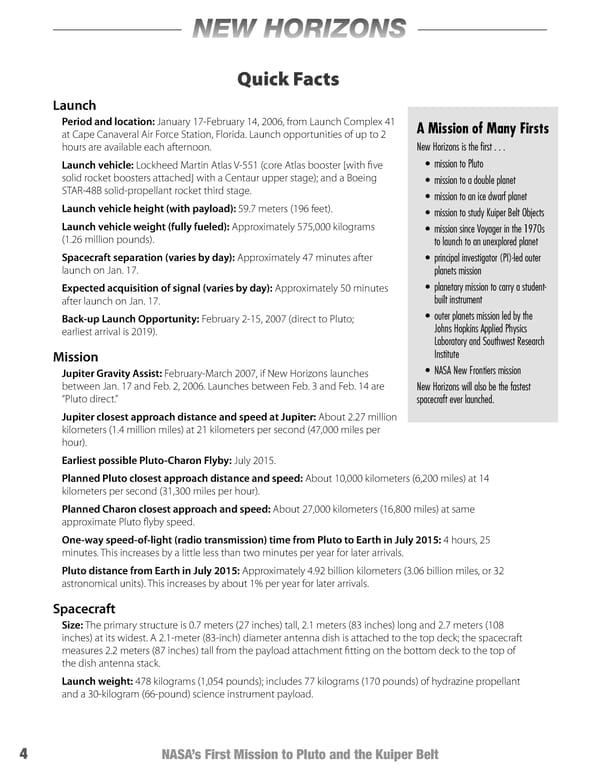NEW HORIZONS Quick Facts Launch Period and location: January 17-February 14, 2006, from Launch Complex 41 A Mission of Many Firsts at Cape Canaveral Air Force Station, Florida. Launch opportunities of up to 2 hours are available each afternoon. New Horizons is the first . . . Launch vehicle: Lockheed Martin Atlas V-551 (core Atlas booster [with five • mission to Pluto solid rocket boosters attached] with a Centaur upper stage); and a Boeing • mission to a double planet STAR-48B solid-propellant rocket third stage. • mission to an ice dwarf planet Launch vehicle height (with payload): 59.7 meters (196 feet). • mission to study Kuiper Belt Objects Launch vehicle weight (fully fueled): Approximately 575,000 kilograms • mission since Voyager in the 1970s (1.26 million pounds). to launch to an unexplored planet Spacecraft separation (varies by day): Approximately 47 minutes after • principal investigator (PI)-led outer launch on Jan. 17. planets mission Expected acquisition of signal (varies by day): Approximately 50 minutes • planetary mission to carry a student- after launch on Jan. 17. built instrument Back-up Launch Opportunity: February 2-15, 2007 (direct to Pluto; • outer planets mission led by the earliest arrival is 2019). Johns Hopkins Applied Physics Laboratory and Southwest Research Mission Institute Jupiter Gravity Assist: February-March 2007, if New Horizons launches • NASA New Frontiers mission between Jan. 17 and Feb. 2, 2006. Launches between Feb. 3 and Feb. 14 are New Horizons will also be the fastest “Pluto direct.” spacecraft ever launched. Jupiter closest approach distance and speed at Jupiter: About 2.27 million kilometers (1.4 million miles) at 21 kilometers per second (47,000 miles per hour). Earliest possible Pluto-Charon Flyby: July 2015. Planned Pluto closest approach distance and speed: About 10,000 kilometers (6,200 miles) at 14 kilometers per second (31,300 miles per hour). Planned Charon closest approach and speed: About 27,000 kilometers (16,800 miles) at same approximate Pluto flyby speed. One-way speed-of-light (radio transmission) time from Pluto to Earth in July 2015: 4 hours, 25 minutes. This increases by a little less than two minutes per year for later arrivals. Pluto distance from Earth in July 2015: Approximately 4.92 billion kilometers (3.06 billion miles, or 32 astronomical units). This increases by about 1% per year for later arrivals. Spacecraft Size: The primary structure is 0.7 meters (27 inches) tall, 2.1 meters (83 inches) long and 2.7 meters (108 inches) at its widest. A 2.1-meter (83-inch) diameter antenna dish is attached to the top deck; the spacecraft measures 2.2 meters (87 inches) tall from the payload attachment fitting on the bottom deck to the top of the dish antenna stack. Launch weight: 478 kilograms (1,054 pounds); includes 77 kilograms (170 pounds) of hydrazine propellant and a 30-kilogram (66-pound) science instrument payload. 4 NASA’s First Mission to Pluto and the Kuiper Belt
 New Horizons Page 8 Page 10
New Horizons Page 8 Page 10